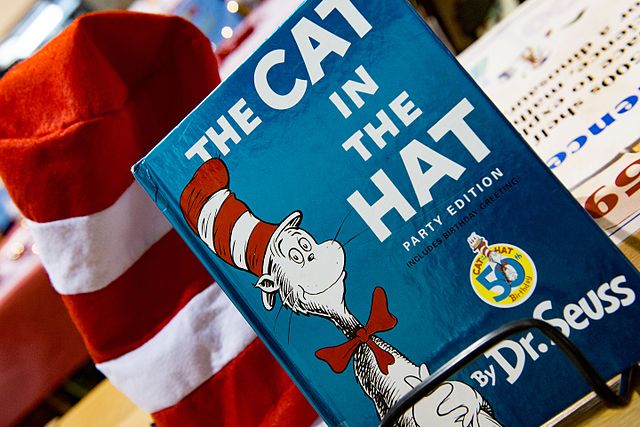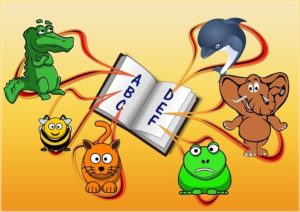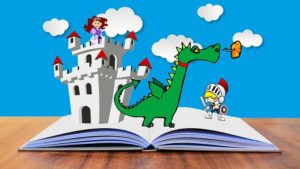
Remember those READ posters of movie stars and other celebrities? Though the appeal of posters is their retro look, the message is still very relevant today. So engage your students and talk about literacy with some fun activities on March 2nd for National Read Across America Day!
What is National Read Across America Day?
National Read Across America Day, also known as Dr. Seuss Day, is an important day for educators of all subject areas, but Spanish teachers especially can appreciate the significance of today’s focus on language skills. Celebrate this day with your students to show them that you think developing literacy skills are important, no matter the age of the reader. After all, literacy impacts everything, even a person’s health, so making the time for reading is most certainly worthwhile.
Make the most of this day and draw attention to the value of reading, both at home and in school. The importance of reading at home and in school has been documented by researchers all over the world, but why should their findings mean anything to us? Well, basically, reading at home reinforces learning that takes place at school; when parents and siblings and other family members read too, it becomes more fun for everyone involved. Take in other considerations like enjoying the benefits of slowing down and being exposed to new vocabulary on a regular basis, and reading at home becomes of critical importance. Encourage your students to read at home with assignments that reward this behavior, and see if reading takes hold as a lifelong healthy habit.
And by the way, National Read Across America Day is also known as Dr. Seuss Day. Dr. Seuss was the pen name of Theodore Seuss Geisel, who was a German-American author of over 60 children’s books; some say he belongs on the list of the top-ten best-selling authors of all time. His contributions to children’s literature are important and worthy of commemoration because his books are beloved by children who have been inspired to read more thanks to their enjoyment of his stories. The Dr. Seuss style is distinctive and fun, and the graphics mesmerizing, so his books will certainly be popular with children for decades to come.
Ideas for Reading More in English… and in Spanish!
 Full or partial immersion classrooms that give students a more thorough experience in Spanish offer students countless opportunities to read more in Spanish. If students are learning how to write in Spanish, subscribe to educational magazines like Highlights High Five Bilingüe. You could even offer extra credit options or for-credit homework assignments out of this kind of reading material.
Full or partial immersion classrooms that give students a more thorough experience in Spanish offer students countless opportunities to read more in Spanish. If students are learning how to write in Spanish, subscribe to educational magazines like Highlights High Five Bilingüe. You could even offer extra credit options or for-credit homework assignments out of this kind of reading material.
As well, lots of editions of children’s literature are now available in English and Spanish. Even if your students are older, they will enjoy reading old favorites from childhood in Spanish. As well, it could make for a satisfying volunteer project to take their reading and pronunciation skills outside their own classroom to local primary schools and libraries who might need readers for their youngsters.
So how best to motivate your students to read more? It’s simple: encourage them all the time, and then reward them when they do it. The rewards do not have to be material. Just a sincere smile and a genuine “Well-done, you!” when a student tells you about translating the menu at Taco Bell for his family is enough. Celebrate the small moments with your students to build a positive connection between you both and between the words that you read, together at school and separately at home.
3 On-line Spanish Reading Activity Ideas
-
 Spanish Picture Dictionary (Novice-High to Intermediate Spanish)
Spanish Picture Dictionary (Novice-High to Intermediate Spanish)
Learning objective: Students will create a Spanish picture dictionary. How to do this activity: Students will have access to the https://www.spanish.cl/reading.htm site with a number of short stories from which to choose. Each story has a vocabulary list of common terms associated with the topic. Begin by breaking the students into small groups of 2 or 3. Have the students scroll through the website and choose a topic that interests them. Write the topics that have been chosen on the board, so each group will have their own story with which to work.Have the students scroll to the bottom of the story pages to the vocabulary and verb lists provided. The students will create a Spanish picture dictionary with the Spanish term, definition and picture that pertains to the term. If you wish, you can have them include the term being used in a sentence, either from the story provided or one they have created themselves.
They can choose the lay-out they wish to use (on paper, Google Slides, Canva, StoryJumper, etc.). Their final product should have the topic they chose (i.e. El aeropuerto) and a pleasing lay-out that is easily viewable and navegable. Add these picture dictionaries to your classroom libraries or add them to your LMS for easy access.
 Let’s create a story book! (Novice-High to Intermediate Spanish)Learning objective: Students will create a story book based on a children’s book classic to share with the class.How to do this activity: Students will have access to the https://www.cuentosinfantilescortos.net/cuentos/cuentos-clasicos/ site with a number of short stories from which to choose. Each story has a YouTube video which narrates the story, in Spanish, while scrolling the text across the bottom. (Note: If the speed of reading is too fast, the settings can be adjusted to play the audio at .75 or .50 speed.)Begin by breaking the students into small groups of 3 or 4. Have the students scroll through the website and choose a story they wish to recreate. Write the stories that have been chosen on the board, so each group will have their own story with which to work.Have the students create an online book or one on paper (depending on time and artistic ability of your students). The online storybook platform www.storyjumper.com is an easy-to-use technology tool that provides students with a number of lay-outs and graphics to add to their story.
As the students work, provide them with any help needed to understand vocabulary shown in their story. You can also monitor their group work and keep them moving in the right direction to complete their book in a timely manner.
Let’s create a story book! (Novice-High to Intermediate Spanish)Learning objective: Students will create a story book based on a children’s book classic to share with the class.How to do this activity: Students will have access to the https://www.cuentosinfantilescortos.net/cuentos/cuentos-clasicos/ site with a number of short stories from which to choose. Each story has a YouTube video which narrates the story, in Spanish, while scrolling the text across the bottom. (Note: If the speed of reading is too fast, the settings can be adjusted to play the audio at .75 or .50 speed.)Begin by breaking the students into small groups of 3 or 4. Have the students scroll through the website and choose a story they wish to recreate. Write the stories that have been chosen on the board, so each group will have their own story with which to work.Have the students create an online book or one on paper (depending on time and artistic ability of your students). The online storybook platform www.storyjumper.com is an easy-to-use technology tool that provides students with a number of lay-outs and graphics to add to their story.
As the students work, provide them with any help needed to understand vocabulary shown in their story. You can also monitor their group work and keep them moving in the right direction to complete their book in a timely manner.
Once the students have created their books, have them partner up with another group and share their stories. The students in each group should then take turns reading, while showing their story to the other group.
 Bilingual Story Time (Intermediate to Advanced Spanish)Learning objective: Students will develop a bilingual story based on a topic of their choosing.How to do this activity: Students will have access to the https://www.spanish.cl/reading.htm site with a series of stories, broken down by topic, from which to choose. (Each story has a vocabulary list, at the bottom, to help guide their reading.)Begin by breaking the students into small groups of 3 or 4. Have the students scroll through the website and choose a story they wish to recreate. Write the stories that have been chosen on the board, so each group will have their own story with which to work.Have the students create a Google Slides presentation where they retell the story. They will include the Spanish sentences with an English translation on each Slide. They also should find a picture that best represents what the sentences say.
Bilingual Story Time (Intermediate to Advanced Spanish)Learning objective: Students will develop a bilingual story based on a topic of their choosing.How to do this activity: Students will have access to the https://www.spanish.cl/reading.htm site with a series of stories, broken down by topic, from which to choose. (Each story has a vocabulary list, at the bottom, to help guide their reading.)Begin by breaking the students into small groups of 3 or 4. Have the students scroll through the website and choose a story they wish to recreate. Write the stories that have been chosen on the board, so each group will have their own story with which to work.Have the students create a Google Slides presentation where they retell the story. They will include the Spanish sentences with an English translation on each Slide. They also should find a picture that best represents what the sentences say.
As the students work, provide them with any help needed to understand vocabulary shown in their story. You can also monitor their group work and keep them moving in the right direction to complete their Slides in a timely manner.
Once the students have created their bilingual story, have them partner up with another group and share what they have created. The students in each group should then take turns reading, while showing their story to the other group.
4 Spanish Vocabulary-Building Activities with Dr. Seuss Books
All of these activities require a small library of the suggested Dr. Seuss books in English and Spanish, ideally one copy for each student. As well, if at all possible, have a copy of The Cat in the Hat Beginner Book Dictionary in Spanish available for all students to consult (even better, if your students are beginners and resources allow it, suggest that all students to have their own copy that they must bring to class with them; this easy-to-use dictionary is a perfect reference for young beginning Spanish learners).
Feel free to swap in your favorite Dr. Seuss titles for the suggested titles in the activities below, but remember that not all Dr. Seuss books have been written for the same reading level. The two books selected for the beginning Spanish students are among the Dr. Seuss titles best suited for early readers as they contain a lot of repetition and simple language. The two books for the intermediate and advanced students are somewhat more complex, but still appropriate for young readers.
1. Bilingual Dramatizations of Dr. Seuss (Beginner Spanish): Huevos Verdes con Jamón (Green Eggs & Ham)
Learning objective: Students will compare and contrast English text with the Spanish version and incorporate movement into their reading/speaking practice.
How to do this activity: Students will have access to the Cat in the Hat Dictionary as well as a copy of Green Eggs & Ham and a copy of Huevos Verdes con Jamón.
Begin by reading the English version out loud to your students to familiarize them with the story while they read along silently.
As well, use this activity as an opportunity to introduce the idea of incorporating movement into the reading experience. For example, at the beginning, assign different volunteers words and ask them to stand up when they hear their word. Another idea is to ask the volunteers to assign a creative gesture to a phrase (so if the student is assigned ‘in a house,’ the student might stand up with arms overhead to demonstrate a roof).
Once this exercise goes smoothly, explain that you will now read the book out loud to them in Spanish, and the same students will do the same movements; this time, however, they must listen for their phrase in Spanish.
Allow time to review the vocabulary necessary and to give all students an opportunity to listen and move. Remind students that reading along while listening provides excellent reinforcement of important reading skills like pronunciation, spelling and vocabulary-building.
2. Creative Vocabulary Charts (Beginner Spanish): Un Pez, Dos Peces, Pez Rojo, Pez Azul (One Fish, Two Fish, Red Fish, Blue Fish)
Learning objective: Students will color-code vocabulary words according to these five different categories: colors, numbers, adjectives, verbs, and nouns.
How to do this activity: Students will have access to the Cat in the Hat Dictionary as well as a copy of Un Pez, Dos Peces, Pez Rojo, Pez Azul.
Before starting this activity in class, write the different categories of words across the top of the board and invite students to offer one or two random examples of each category to place beneath each category title. If necessary, remind students of what each grammatical term means. Color code each category with a different color of marker or chalk, and ask students to bring out their marker pens or crayons in the same five colors.
Then, ask the students to work independently and to read the first four or five pages of the book silently to themselves, writing down and color-coding different words they see in the text of the book.
After everyone appears to have finished, allow them to compare notes with each other; remind everyone that is perfectly fine if the lists are different from each other.
Carry on as long as your class period allows, or do this activity a few pages at a time over the course of a week or two as a fun way to end class. Make sure you leave enough time to read the book out loud, as listening to the rhythm of the rhyme and word choice is half the fun!
3. Reverse Translation (Intermediate Spanish)
Learning objective: Students will use their inference skills to translate Spanish versions of a familiar story into English: El Gato ensombrerado (The Cat in the Hat)
How to do this activity: Divide students up into groups of two or three, and ask them to come together with their copies of El Gato ensombrerado.
Assign group members different roles; for example, one student can read the book out loud in Spanish, one student can be the scribe to jot down new and interesting Spanish words and their inferred English definitions, and if there is a third student in the group, he or she can string ideas together into a written summary of the book.
Let students work at their own pace and think through the possible meanings of new words. At the end of the activity, allow the students to check their English translations in the dictionary to see which ones they got right.
4. Taking a Turn as Teacher (Advanced Spanish)
Learning objective: Students will create a vocabulary lesson plan to teach to beginning learners the book ¡Oh,cuán lejos llegarás! (Oh, the Places You’ll Go!)
How to do this activity: By way of introducing this activity, explain to your students that one of the best ways to learn a concept is to teach it. Let them know that they will each be designing a vocabulary lesson plan around the Dr. Seuss book¡Oh, cuán lejos llegarás!, and if you have time, you can even offer them an opportunity to teach it to the rest of the class as a way to extend the activity.
Give them a lesson plan template, plenty of class time to brainstorm and to discuss ideas with you and with each other, and require them to bring in some sort of teaching resource or visual aid of their own creation with the completed template as a way for you to assess their lesson plan.
If your school has elementary students in the same building, or nearby, you could speak with your colleagues in the lower grades about letting your most ambitious and reliable students guest-teach for a class period. The younger students will absolutely love an older student coming in to spend time with them.
Spanish teachers can access hundreds of lesson plans, printables, song activities and class resources at the Speaking Latino Spanish Teacher Community. Join now!
 Spanish Picture Dictionary (Novice-High to Intermediate Spanish)
Spanish Picture Dictionary (Novice-High to Intermediate Spanish) Let’s create a story book! (Novice-High to Intermediate Spanish)
Let’s create a story book! (Novice-High to Intermediate Spanish) Bilingual Story Time (Intermediate to Advanced Spanish)
Bilingual Story Time (Intermediate to Advanced Spanish)




